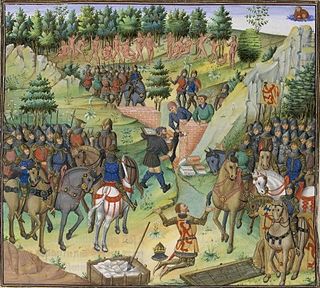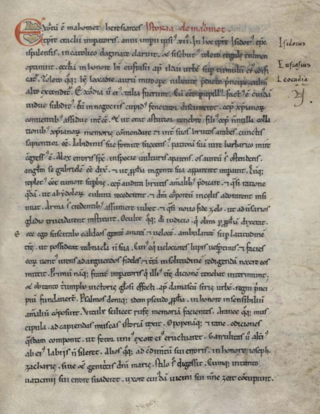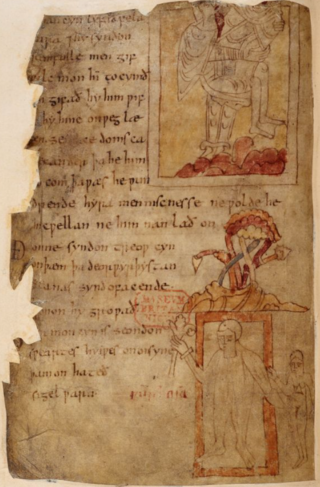
Barlaam and Josaphat, also known as Bilawhar and Budhasaf, are Christian saints. Their life story was based on the life of the Gautama Buddha, who historically lived several centuries before Jesus. Their story tells of the conversion of Josaphat to Christianity. According to the legend, an Indian king persecuted the Christian Church in his realm. After astrologers predicted that his own son would some day become a Christian, the king imprisoned the young prince Josaphat, who nevertheless met the hermit Saint Barlaam and converted to Christianity. After much tribulation the young prince's father accepted the Christian faith, turned over his throne to Josaphat, and retired to the desert to become a hermit. Josaphat himself later abdicated and went into seclusion with his old teacher Barlaam.

Gog and Magog or Yajuj and Majuj are a pair of names that appear in the Bible and the Quran, variously ascribed to individuals, tribes, or lands. In Ezekiel 38, Gog is an individual and Magog is his land. By the time of the New Testament's Revelation 20:8, Jewish tradition had long since changed Ezekiel's "Gog from Magog" into "Gog and Magog".

Written in Syriac in the late seventh century, the Apocalypse of Pseudo-Methodius shaped and influenced Christian eschatological thinking in the Middle Ages. Falsely attributed to Methodius of Olympus, a fourth century Church Father, the work attempts to make sense of the Islamic conquest of the Near East.
Lamprecht, called der Pfaffe, was a German poet of the twelfth century. He is the author of the Alexanderlied, the first German epic composed on a French model.

The Alexander Romance, once described as "antiquity's most successful novel", is an account of the life and exploits of Alexander the Great. The Romance describes Alexander the Great from his birth, to his succession of the throne of Macedon, his conquests including that of the Persian Empire, and finally his death. Although constructed around an historical core, the romance is mostly fantastical, including many miraculous tales and encounters with mythical creatures such as sirens or centaurs. In this context, the term Romance refers not to the meaning of the word in modern times but in the Old French sense of a novel or roman, a "lengthy prose narrative of a complex and fictional character".
The Rawlinson Excidium Troie, discovered among the manuscripts collected by Richard Rawlinson (1690–1755) conserved in the Bodleian Library, Oxford, is unique in that it contains the only medieval account of the Trojan War that is fully independent of Dictys and Dares, "strikingly different from any other known mediaeval version of the Trojan War", according to its editor, E. Bagby Atwood. Its discovery revealed a source for many details in medieval texts whose sources had been obscure, not appearing in the familiar Latin epitomes of the Iliad, through which Homer was transmitted to medieval culture, the Greek text being lost to Western Europe.

Various species of mythical headless men were rumoured, in antiquity and later, to inhabit remote parts of the world. They are variously known as akephaloi or Blemmyes and described as lacking a head, with their facial features on their chest. These were at first described as inhabitants of ancient Libya or the Nile system (Aethiopia). Later traditions confined their habitat to a particular island in the Brisone River, or shifted it to India.

Odontotyrannos, also odontotyrannus or dentityrannus ("tooth-tyrant") is a mythical three-horned beast said to have attacked Alexander the Great and his men at their camp in India, according to the apocryphal Letter from Alexander to Aristotle and other medieval romantic retellings of Alexandrian legend.

The vast conquests of the Macedonian king Alexander the Great quickly inspired the formation and diffusion of legendary material about his deity, journeys, and tales. These appeared shortly after his death, and some may have already begun forming during his lifetime. Common themes and symbols, among legends about Alexander include the Gates of Alexander, the Horns of Alexander, and the Gordian Knot.
Julius Valerius Alexander Polemius was a translator of the Greek Alexander Romance, a romantic history of Alexander the Great, into Latin under the title Res gestae Alexandri Macedonis. The work is in three books on his birth, acts and death. The work is important in connection with the transmission of the Alexander story in the Middle Ages.
The Res gestae Alexandri Macedonis is the earliest Latin translation of the Alexander Romance, usually dated between 270–330 AD and attributed to Julius Valerius Alexander Polemius. It is not the earliest Latin composition on Alexander the Great of any kind however, as already in the first century Quintus Curtius Rufus composed a lengthy historical account of Alexander's career in the language. It is also not to be confused with similarly titled works, such as the Res Gestae of Ammianus Marcellinus or the Res Gestae Divi Augusti, a monumental inscription erected by the Roman emperor Augustus.
The Syriac Alexander Legend, is a Syriac legendary account of the exploits of Alexander the Great composed in the sixth or seventh century. For the first time in this text, the motifs of Alexander's gate, an apocalyptic incursion, and the barbarian tribes of Gog and Magog are fused into a single narrative. The Legend would go on to influence Syriac literature about Alexander, like in the Song of Alexander. It would also exert a strong influence on subsequent apocalyptic literature, like the Apocalypse of Pseudo-Methodius composed in the late seventh century. In Quranic studies, the representation of Alexander in the Legend is also seen as closely related to the Quranic figure named Dhu al-Qarnayn.
Leo of Naples, also called Leo the Archpriest, was a diplomat and translator in the service of Dukes John III and Marinus II of Naples. He undertook a diplomatic mission to Constantinople, the capital of the Byzantine Empire, during the joint reign of Constantine VII and Romanus II between 945 and 959. During his time in the capital, he came across the Alexander Romance, a collection of Greek stories about Alexander the Great, and had a copy made for Theodora, the wife of John III. After Theodora's death, John commissioned Leo to translate the Romance into Latin. The date of Theodora's death is unknown, but she was still living in 951. John died in 968 or 969. All that is known of Leo comes from the prologue he wrote to this translation, in which he calls himself an archipresbyter.
The Historia de preliis Alexandri Magni (History of Alexander's Battles), more commonly known as the Historia de preliis (History of Battles), refers to a Latin translation and the main abridgements of a work that was originally as the Nativitas et victoria Alexandri Magni regis. This work was first produced by Leo the Archpriest in the tenth century as a Latin translation of the Greek Alexander Romance of Pseudo-Callisthenes. Between the twelfth and fifteenth centuries, the Historia went through three major recensions and it is through these recensions that the text is known today as the original is lost. The three recensions are called I1, I2, and I3 (also called J1, J2, and J3 in some publications). Their influence was enormous on medieval European literature, spawning an immense number of translations into almost every vernacular and subsequently making Alexander a household name in the European Middle Ages. The Alexander Romance, through the Latin Historia, underwent more translations than any text with the exception of the Gospels.

The Storia de Mahometh is a short anonymous polemical Latin biography of Muḥammad written from a Christian perspective, probably in al-Andalus between about 750 and 850. It contains the earliest known translation into Latin of any portion of the Qurʾān.

The Epistola Alexandri ad Aristotelem is a purported letter from Alexander the Great to the philosopher Aristotle concerning his adventures in India. Although accepted for centuries as genuine, it is today regarded as apocryphal. It is the primary source for most of the tales of the marvellous and fabulous found in later Alexander traditions.
The Qiṣṣat al-Iskandar is the earliest narrative of Alexander the Great in the tradition of the Alexander Romance genre in the Arabic language. It was composed by ‘Umara ibn Zayd (767-815) between the late 8th to the early 9th century as a recension on the Syriac Alexander Legend. It is not to be confused with the Qissat Dhulqarnayn or the Sirat al-Iskandar.

The Armenian Alexander Romance, known in Armenian as The History of Alexander of Macedon, is an Armenian recension of the Greek Alexander Romance from the fifth-century incorporating many of its own elements, materials, and narratives not found in the original Greek. While the text did not come to have any substantial influence on Eastern legend, the Armenian romance is considered to be a highly important resource in reconstructing the text of the original Greek romance. The text continued to be copied until the eighteenth century, and the first scholar and Armenian to substantially study the text was Father Raphael Tʿreanc, and he was the first to publish the text in its Armenian form, in 1842.
The Syriac Alexander Romance is an anonymous Christian text in the tradition of the Greek Alexander Romance of Pseudo-Callisthenes, potentially translated into Syriac the late sixth or early seventh century. Just like the Res gestae Alexandri Macedonis of Julius Valerius Alexander Polemius, the Armenian Alexander Romance and the Historia de preliis of Leo the Archpriest, the Syriac Romance belongs to the α recension of the Greek Romance, as is represented by the Greek manuscript A. Another text, the Syriac Alexander Legend, appears as an appendix in manuscripts of the Syriac Alexander Romance, but the inclusion of the Legend into manuscripts of the Romance is the work of later redactors and does not reflect an original relationship between the two.
Alexander the Great was the king of the Kingdom of Macedon and the founder of an empire that stretched from Greece to northwestern India. Legends surrounding his life quickly sprung up soon after his own death. His predecessors represented him in their coinage as the son of Zeus Ammon, wearing what would become the Horns of Alexander as originally signified by the Horns of Ammon. Legends of Alexander's exploits coalesced into the third-century Alexander Romance which, in the premodern period, went through over one hundred recensions, translations, and derivations and was translated into almost every European vernacular and every language of the Islamic world. After the Bible, it was the most popular form of European literature. It was also translated into every language from the Islamicized regions of Asia and Africa, from Mali to Malaysia.








